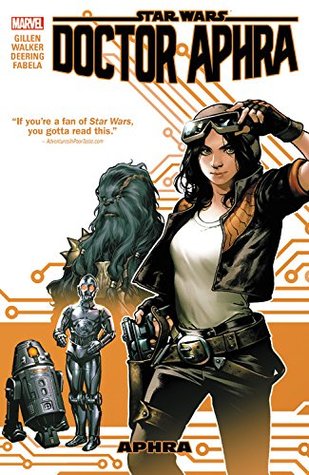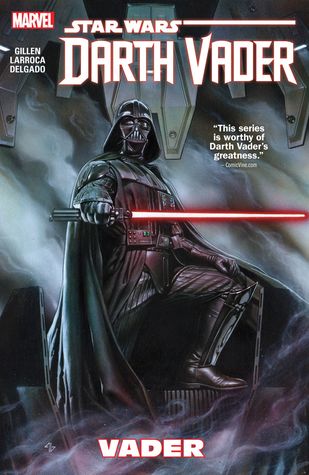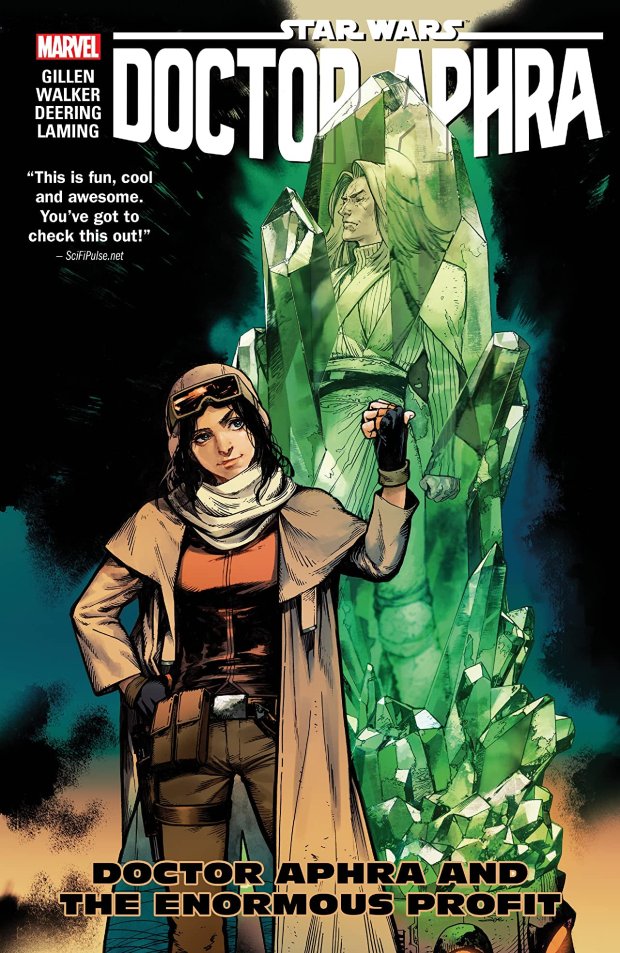May the Fourth be With You!
Happy Star Wars Day from my corner of the galaxy to yours. Here’s to one of my favorite stories of all time, reminding us that hope is always there, and anyone can be a hero.

Doctor Aphra vol 1: Aphra
by Kieron Gillen, Kev Walker, Marc Deering, Antonio Fabela
collects Star Wars: Dr Aphra #1-6
volume reviews: one | two | three | four | five | six | seven [complete]
The debut series of rogue archaeologist, Miss – sorry, Doctor Aphra, was very forgettable, even though I like the character a lot – or at least her potential. I always want to see more women in the Star Wars universe – and queer women in the Star Wars universe, what a concept! (though it was very much tossed in at the end) – but Aphra’s debut series didn’t make much of an impression.
Aphra first debuted in Darth Vader’s series also penned by Kieron Gillen, as a minor character in Vader’s employment, but now she’s free and able to pursue her life’s work: stealing and profiting from ancient artifacts. (note: I read this before reading Vader and I met her briefly in Aaron’s Star Wars title.)
Aphra’s like a Star Wars version of Indiana Jones or Lara Croft, (wrote this then learned Gillen used Indy as inspiration), who shares Han’s snarkiness and comfort in the gray area between hero and villain. Aphra feels like a natural character in the Star Wars universe and she’s got a lot of potential. Gillen gives her a strong voice and it’s truly unclear whether she’s altogether good or bad. The way we learn Aphra is queer leaves no room for questioning it, but is also subtle enough that it’s just one of many aspects about her, which is so necessary these days.
(And I just have to mention, again, she’s one of very very very few queer women, and women of color, in Star Wars so it’s kind of a big deal. Though it would have also been nice if the creative team was one or more of those things – maybe eventually they’ll hand it off.)
But then, the plot goes sideways with her father and a confusing mythology story that seemed too big and important for one trade, but also wasn’t given a whole lot of time. This is where the book lost me. Even though Gillen gives lil boop and her dad time to (predictably) work things out, it isn’t really her story when it’s primarily centered around her dad’s life’s work. Aphra’s compatriots, Black Krrstantan, Beetee and Triple Zero had some nice quips, but I had trouble getting beyond how they’re just an inverted image of Chewie, Artoo and Threepio. Finally I wasn’t crazy about the art, which had more than a few sloppy panels, and didn’t bring any “wow” moments, especially from the fight scenes, that really elevated the early volumes of Aaron’s Star Wars title.
I’ll give the next volume a shot. Until then, I’ll dream of a time when a queer woman of color’s creative team isn’t all white dudes…over seven volumes. Sheesh.
 Star Wars vol 4: Last Flight of the Harbinger
Star Wars vol 4: Last Flight of the Harbinger
by Jason Aaron, Mike Mayhew, Jorge Molina, Chris Eliopoulos
collects Star Wars Annual #20-25
volume one | two | three | four
Even though it’s better than volume 3, Last Flight of the Harbinger still leaves a lot to be desired.
Harbinger begins with another one shot of Ben’s time on Tattooine, babysitting Luke from afar. Mayhew’s photorealistic art is amazing but the stories have no substance or consequence – though it was fun to see Black Krrsantan make an appearance right after reading Dr Aphra. I know there’s only so much Aaron can do in this timeline, but it had better be leading up to something – and what about some time with Aunt Beru? Has there ever been ANY story about her?
The main arc sees Luke, Han, Leia and Sana hijack a Star Destroyer in order to save a Rebellion-sympathizing planet under the Imperial’s blockade. It’s a cool concept, but the character work is still weak. Han and Leia won’t stop bickering, and it’s more than tired at this point. We all know their romantic tension can’t be resolved until after Episode V, and I’m really dismayed that Aaron still can’t find any better character development for them, as if there isn’t any more to Han and Leia’s characters than sexual tension. Sana, who seemed to be brought in less as a full fledged character and more as a shit-stirrer, isn’t given more personality or much to do; it was refreshing to see her paired with Luke, but their scene doesn’t go anywhere. Aaron also introduces the Scar Squad, an elite squad of Stormtroopers – like an Imperial version of the Bad Batch in Clone Wars – and the backstory behind Sergeant Kreel was surprisingly compelling.
Jorge Molina’s art is alright. I love his starship battle scenes and he does a beautiful job rendering ships, space, and movement all alongside speech bubbles, which is not a small feat. But I’m not a fan of Molina’s button noses, which threw off all the characters for me, except maybe Sana.
Aaron’s Star Wars title isn’t high on my list, but it was an easy read (especially on May the 4th!) and I’ll give volume five a look when I’m up for it.
 Darth Vader vol 1: Vader
Darth Vader vol 1: Vader
by Kieron Gillen, Salvador Larocca & Edgar Delgado
collects Darth Vader #1-6
Vader was a quick read that helped connect the dots with Aphra and the main Star Wars title. It was moderately enjoyable but far from my favorite book this year.
As the only survivor of the Death Star’s destruction, Vader is the target of Palpatine’s wrath and gets a big ol demotion. He’s now the pawn of General Tagge who only sees him as a brute force. But of course Vader won’t have that, as he recruits familiar and new faces to find Luke and build himself an army.
Gillen’s restricted by the later films, and so it’s never a question that Vader gets back on top. Enjoying the story depends on how much one likes Vader, and/or any investment in the secondary and mostly original cast: rogue archaeologist Dr. Aphra, assassin versions of 3PO and R2D2, mercenary wookie Black Krrsantan, and some other minor cameos. (And Palpatine, I guess. Is anyone a fan of Palpatine?) The events in this volume nicely tie into Aaron’s first Star Wars volume, but most importantly, Gillen has a strong handle on Vader’s ruthless and calculating voice, with just enough pain underneath the surface, but only for the reader to fully understand. Vader is far from my favorite Star Wars character, but Gillen hits the right notes here. The final reveal – for Vader at least – is handled beautifully, and answers a big question in Star Wars canon.
What I didn’t get was how Vader found all the time to multitask right after becoming Tagge’s errand boy, and there’s nothing like an alien bug queen screaming “my womb! my children!” for my inner feminist to cringe a bit.
I’m torn on the art. Larocca’s pencils felt very shaky and inconsistent, and he constantly drew characters who were speaking with their mouths closed, which bothered me for some reason. Delgado’s colors are phenomenal, adding in some lovely shading and Vader-helmet shininess that elevate Larocca’s pencils and really make the story feel like Star Wars.
Vader is unnecessary but helpful for this new landscape of Marvel comics, and a must for Vader fans. Personally, I’m not sure I’ll continue with volume two – it depends on how many other Star Wars comics I read and if I feel it’s necessary.


 Star Wars vol 4: Last Flight of the Harbinger
Star Wars vol 4: Last Flight of the Harbinger Darth Vader vol 1: Vader
Darth Vader vol 1: Vader



